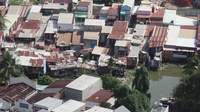klimawandel
City Resilience Program
Cities need to prepare for natural disasters in a more systematic manner so that they can better withstand the effects of climate change.
Climate change-related natural disasters threaten millions of people – especially in cities. The higher the population density, the more destructive the impact of natural disasters on local populations and the economy.
Today's cities are growing rapidly. For the first time in human history, more people live in cities than in rural areas. Globally, urban settlements are growing by an extra 1.4 million people every week. 90% of this increase takes place in cities in developing countries.
Many cities in developing countries are experiencing unplanned and uncontrolled growth. Settlement areas are emerging in high-risk territory, such as flood-prone coastal areas and rivers. The poorer the people living in these areas are, the more vulnerable they tend to be.
The Vietnamese city of CanTho is an important economic centre in the Mekong Delta. In 2018, a massive flood hit the city. CanTho did not have the means to prevent such disasters at the time.
In the future, cities like CanTho should be better prepared for natural disasters caused by climate change and should be able to contain the negative consequences. That is why Switzerland and the World Bank have launched the City Resilience Program. This program helps participating cities identify risks and measures and supports them in mobilising necessary funding.
Switzerland has a great deal of experience in managing the effects of climate change, such as persistent rainfall, snowy winters and changes in permafrost. It also has expertise in mitigating the impact of floods, rockfall and avalanches. In 2018, Swiss companies with the respective know-how began transferring their knowledge to developing countries as part of the City Resilience Program.
SECO Website: Developing cities sustainably
SECO Website: Developing cities sustainably
Scroll down to continue
Swipe to continue
Swipe to continue





















